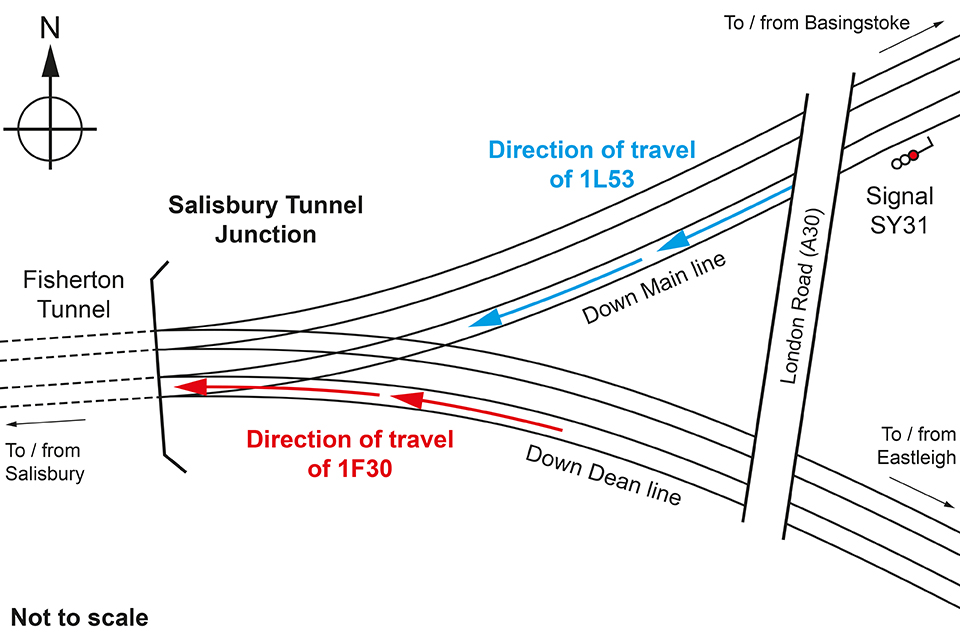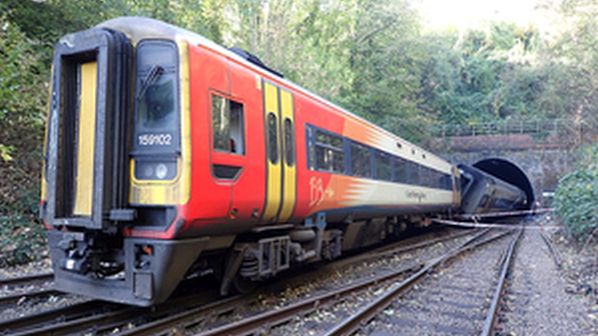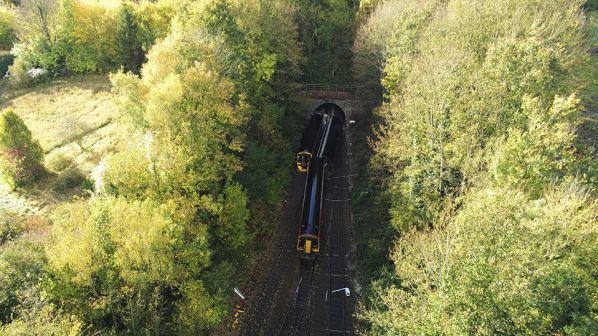BRITAIN’s Rail Accident Investigation Branch (RAIB) says its preliminary examination of a crash between two trains in Salisbury on October 31 has found low adhesion between the train’s wheels and the rails was “almost certainly” the cause.
At around 18:45, South Western Railway (SWR) passenger service 1L53 from London Waterloo to Honiton collided with the side of Great Western Railway (GWR) passenger service 1F30 from Portsmouth Harbour to Bristol Temple Meads. The collision occurred at Salisbury Tunnel Junction, on the immediate approach to Fisherton tunnel.
The junction allows the up and down dean lines to Eastleigh to merge with the up and down main lines to Basingstoke. At the time of the accident, train 1F30 was using the junction to join the down main line from the down dean line, while train 1L53 was approaching the junction on the down main line from the direction of Basingstoke.

The impact of the collision caused the front two coaches of train 1L53 and the rear two coaches of train 1F30 to derail. Both trains continued some distance into Fisherton tunnel following the collision before they came to a stop. 13 passengers and a member of railway staff required treatment in hospital as a result of the accident, which also caused significant damage to the trains and railway infrastructure involved.
RAIB says its preliminary examination found that the movement of train 1F30 across the junction was being protected by a signal on the down main line which was at danger, with this signal passed by train 1L53 by around 220m immediately prior to the collision.
Preliminary analysis of data downloaded from the on-train data recorder (OTDR) fitted to train 1L53 shows that the driver initially applied service braking to slow the train on approach to the caution signal before the at-danger signal. Around 12 seconds after service braking started, the driver made an emergency brake demand. As the train approached signal, and with the emergency brake still being demanded by the driver, a second emergency brake demand was made by the train protection and warning system (TPWS).

These emergency brakes did not prevent the train from reaching the junction where the collision occurred. OTDR analysis indicates that wheel slide was present both when the driver applied service braking and after emergency braking was demanded. This was almost certainly a result of low adhesion between the train’s wheels and the rails.
RAIB has launched an investigation to identify the sequence of events which led to the accident, which will also consider:
- the level of wheel-rail adhesion present on the approach to Salisbury Tunnel junction
- the status and performance of the braking, wheel slide protection and sanding systems on train 1L53
- the behaviour of both trains during and following the collision
- SWR’s policies relating to low wheel-rail adhesion
- infrastructure manager Network Rail’s (NR) policies relating to low wheel-rail adhesion and how it managed the risk of low adhesion in this area
- the processes used to assess and control the risk of overrun at the signal that was at danger, and
- any relevant underlying factors, including any actions taken in response to previous safety recommendations.
The investigation is independent of any investigation by the industry, the British Transport Police or by the British rail regulator, the Office of Rail and Road (ORR).
“We welcome RAIB’s update on the scope and aims of its investigation,” says SWR managing director, Ms Claire Mann. “It is right that they look into all the possible causes of the lack of adhesion between the train and the track, and we are pleased their early assessment shows the South Western Railway driver reacted correctly to the signals by braking to slow the train down. We believe his actions went some way to preventing a much more serious incident and we wish him a speedy recovery.
“We will continue to work closely with the relevant authorities and our industry partners on all aspects of the investigation.”
“We want to pay tribute to our driver who was injured on Sunday night,” a SWR spokesperson said. “He is a deeply respected colleague, who has over 50 years’ experience of driving on this route and an excellent professional track record. All our drivers are regularly assessed to the highest standards and he has fully satisfied all requirements. Initial findings indicate that the driver acted in an impeccable way in a valiant attempt to keep his passengers safe, staying at the controls throughout. We thank him for his actions and we wish him a speedy recovery as he continues to be treated in hospital.”
In a joint statement issued on November 4, GWR, SWR and NR said while investigators had handed over the accident site, the line would remain closed until at least November 15.

